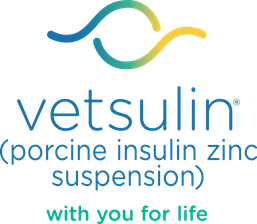

Related Diseases
Read More About Feline Diagnosis & Management
Diseases That May Contribute to the Development of Feline Diabetes
Acromegaly
Acromegaly is a rare endocrine disease caused by excessive secretion of growth hormone by the pituitary gland. In cats, acromegaly results from a pituitary tumor that secretes the excess growth hormone.
Acromegaly is characterized by chronic overgrowth of connective tissue, bone, and viscera. Clinical signs of acromegaly in cats include:
- Insulin-resistant diabetes
- Enlargement of soft tissue organs
- Proliferation of gum tissue
Radiation therapy appears to be the most effective treatment for feline pituitary tumors.
Exocrine Pancreatic Insufficiency (EPI)
EPI is a congenital or acquired condition that can affect both dogs and cats, although it is more common in dogs. In cats, EPI typically manifests as the final stage of pancreatitis. EPI may occur concurrently with diabetes mellitus if both the exocrine and endocrine pancreas are damaged.
EPI pathophysiology
- Digestive enzymes are not secreted normally by the pancreas.
- Food is not sufficiently digested and processed.
- Diarrhea and weight loss occur despite normal or increased appetite.
EPI diagnosis and treatment
EPI is diagnosed based on blood tests and is managed with pancreatic enzyme replacements and dietary management, which usually improve clinical signs. However, if EPI results from chronic pancreatitis accompanied by diabetes mellitus, it can be more difficult to treat.
Feline Hyperthyroidism
Hyperthyroidism is the most common endocrine (hormone) disorder affecting cats. It creates a wide range of clinical signs resulting from the overproduction of thyroid hormone made by the thyroid gland. This condition often presents concurrently with diabetes mellitus.
Common clinical signs of hyperthyroidism include:
- Weight loss
- Polyphagia
- Polyuria
- Polydipsia
- Vomiting
- Diarrhea
- Hyperactivity
- Matted or greasy haircoat
- Palpable thyroid nodule/enlarged thyroid gland
Over time excessive thyroid hormones can cause heart disease and cats may exhibit:
- Heart murmur
- Difficulty breathing
- Tachycardia
- Arrhythmias
Diagnosis of feline hyperthyroidism
In most cats, laboratory measurement of thyroid hormone T4 will confirm the presence of hyperthyroidism. A small percentage of cats with hyperthyroidism will show normal T4 levels. In these cases, if you still suspect a cat has hyperthyroidism, conduct:
- Follow-up total T4 measurement 3 or more weeks later
- Free T4 measurement (by equilibrium dialysis)
- T3 suppression test
Treatment of feline hyperthyroidism:
After you have confirmed a hyperthyroidism diagnosis, 4 treatment options exist including:
- Radioactive-iodine therapy
- Anti-thyroid medications
- Low iodine thyroid diet
- Surgical thyroidectomy
Pancreatitis
Pancreatitis or inflammation of the pancreas causes digestive enzymes to leak into and damage the surrounding pancreatic tissues. In most cases, the cause of pancreatitis is idiopathic; however, risk factors include:
- High-fat, low-protein diet
- Breed – Siamese cats are at higher risk
- Cholangiohepatitis
- Toxoplasmosis
- Feline leukemia virus
- Feline herpesvirus
- Obesity
- Diabetes mellitus
- Cushing’s disease
- Chronic renal failure
- Neoplasia
Acute pancreatitis or pancreatic neoplasia may produce temporary diabetes mellitus. If extensive pancreatic necrosis occurs, diabetes may become a permanent condition.
Help Your Practice Manage Diabetes Mellitus
Check out these tools and resources to help manage feline diabetes.

Blood Glucose Curve Generator
Create a blood glucose curve to monitor and evaluate diabetes treatments.

Client Discharge Form
Create a customized, printable form for clients about their new diagnosis.

Diabetes Resources
Access online tools and more to support staff and pet parents.
No items to show.
Read More About Feline Diagnosis & Management
Important Safety Information:
Vetsulin® should not be used in dogs known to have a systemic allergy to pork or pork products. Vetsulin is contraindicated during periods of hypoglycemia. Keep out of reach of children. As with all insulin products, careful patient monitoring for hypoglycemia and hyperglycemia is essential to attain and maintain adequate glycemic control and prevent associated complications. Overdosage can result in profound hypoglycemia and death. The safety and effectiveness of Vetsulin in puppies, breeding, pregnant, and lactating dogs has not been evaluated. See package insert for full information regarding contraindications, warnings, and precautions.
References:
1. Martin GJ, Rand JS. Pharmacology of a 40 IU/ml porcine lente insulin preparation in diabetic cats: findings during the first week and after 5 or 9 weeks of therapy. J Feline Med Surg. 2001;3(1):23–30. 2. Vetsulin® (porcine insulin zinc suspension) [Freedom of Information Summary]. Millsboro, DE: Intervet Inc.; 2008. 3. Data on file, Merck Animal Health. 4. Graham PA, Nash AS, McKellar QA. Pharmacokinetics of porcine insulin zinc suspension in diabetic dogs. J Small Anim Pract. 1997;38(10):434–438. 5. Martin GJ, Rand JS. Pharmacokinetic and Pharmacodynamic Study of Caninsulin in Cats with Diabetes Mellitus. 2000: Internal Study Report. 6. Feldman EC, Nelson RW. Canine and Feline Endocrinology and Reproduction. 3rd ed. St. Louis, MO: Saunders; 2004:539–579. 7. Tennant B, ed. BSAVA Small Animal Formulary. 4th ed. Gloucestershire, UK: British Small Animal Veterinary Association; 2002. 8. Feldman EC, Nelson RW. Canine and Feline Endocrinology and Reproduction. 3rd ed. St. Louis, MO: Saunders; 2004:486–538. 9. Reusch C. Feline diabetes mellitus. In: Ettinger SJ, Feldman EC, eds. Textbook of Veterinary Internal Medicine. 7th ed. St. Louis, MO: Saunders; 2010:1796–1816. 10. Nelson RW. Canine diabetes mellitus. In: Ettinger SJ, Feldman EC, eds. Textbook of Veterinary Internal Medicine. 7th ed. St. Louis, MO: Saunders; 2010:1782–1796. 11. Burgaud S, Riant S, Piau N. Comparative laboratory evaluation of dose delivery using a veterinary insulin pen. In: Proceedings of the WSAVA/FECAVA/BSAVA congress; 12–15 April 2012; Birmingham, UK. Abstract 121. 12. Burgaud S, Guillot R, Harnois-Milon G. Clinical evaluation of a veterinary insulin pen in diabetic dogs. In: Proceedings of the WSAVA/ FECAVA/BSAVA congress; 12–15 April 2012; Birmingham, UK. Abstract 122. 13. Burgaud S, Guillot R, Harnois-Milon G. Clinical evaluation of a veterinary insulin pen in diabetic cats. In: Proceedings of the WSAVA/FECAVA/BSAVA congress; 12–15 April 2012; Birmingham, UK. Abstract 45. 14. Davison LJ, Walding B, Herrtage ME, Catchpole B. Anti-insulin antibodies in diabetic dogs before and after treatment with different insulin preparations. J Vet Intern Med. 2008;22:1317-1325. 15. Banfield State of Pet Health 2016 Report. p 12-13.
